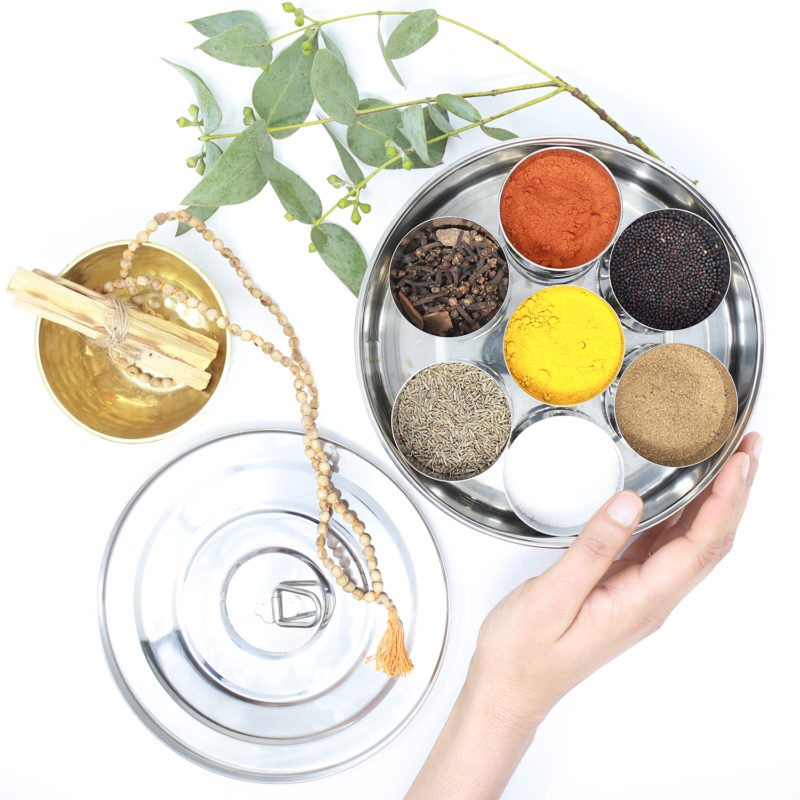
Have you ever wondered what actually accounts for differences in people? Why some people are hyperactive and fast-moving and others exude grace and stillness? Why some people can eat a five-course meal with ease and others can barely finish a salad without feeling digestive distress? Why some people are generally upbeat and others carry the weight of the world on their shoulders? Genetics offers some insight, but what about the characteristics and idiosyncrasies that make every person unique? Ayurveda answers these questions through the doshas, three energetic archetype govern our physical and mental processes, and accordingly, account for the differences in our nature.
These doshas are dynamic and constantly change in response to the foods we eat, our emotions, the seasons, and any other sensory inputs that feed our mind and body. Understanding that we all have unique genetic imprints and life experiences that alter which of these energies are at play, the aim of Ayurveda is to first, bring awareness to which doshas are most dominate in our body-mind, and then guide us towards daily habits that support living in alignment with our most natural state. As it goes, when we live in alignment with true individual nature, we generally make lifestyle and dietary decisions that foster balance within our doshas. When we choose unhealthy patterns, we end up with imbalanced doshas and physical and mental imbalances as a result.
DOSHAS
There are three doshas that derive from the five elements — space, air, fire, earth, water — and their related properties. These three constitutions are Vata, Pitta and Kapha.
VATA
This dosha derives from the elements of space and air and translates as “that which moves things.” It is the energy of movement and the force governing all biological activity. Vata is often called the “King of the doshas,” since it governs the body’s greater life force and gives motion to Pitta and Kapha.
The qualities of Vata are dry, rough, light, cold, subtle, and mobile. A Vata individual will display physical and mental characteristics that reflect these qualities in both a balanced and an imbalanced state. Physiologically, Vata governs anything related to movement, such as breathing, talking, nerve impulses, movements in the muscles and tissues, circulation, assimilation of food, elimination, urination, and menstruation. Psychologically, Vata governs communication, creativity, flexibility, and quickness of thought.
Clues that you may be Vata dominant:
- Creative
- Quick to learn and grasp new knowledge, but also quicker to forget
- Slender, tall, long-limbed
- Tendency toward cold hands and feet & discomfort in cold climates
- Excitable, lively, fun personality
- Changeable moods, irregular daily routine
- Tendency to tire easily and to overexert
- Joyful and enthusiasm when in balance
- Responds to stress with fear, worry, and anxiety, especially when out of balance
- Generally tend towards dry skin and dry hair and don’t perspire much
Tips to Balance Vata:
- Maintain regular habits — try to eat and sleep at the same time every night.
- Choose foods that are warm, cooked, nourishing, and easy to digest.
- Favor exercise that is grounding and slow like meditative yoga, Tai chi, walking, and swimming.
PITTA
This dosha derives from the elements of fire and water and translates as “that which cooks.” It is the energy of digestion and metabolism in the body. While Pitta is most closely related to the element of fire, it is the liquid nature of these substances that accounts for the element of water in pitta’s make-up.
The qualities of Pitta are oily, sharp, hot, light, moving, liquid, and acidic. Physiologically, Pitta provides the body with heat and energy through the breakdown of complex food molecules. It governs all processes related to conversion/transformation throughout the mind and body. Psychologically, Pitta governs joy, courage, willpower, anger, jealousy, and mental perception. It also provides the radiant light of the intellect.
Clues that you may be Pitta dominant:
- Orderly, focused, determined
- Sharp mind with good concentration
- Medium physique, strong, well-built
- Fair skin or reddish and sunburns easily
- Passionate, romantic and confident
- Enjoys challenges and competition but can become self-involved
- Strong appetite and irritable when hungry
- Becomes irritated, aggressive and angry when under stress
- Common physical problems include rashes or inflammations of the skin, heartburn, burning eyes.
Tips to Balance Pitta:
- Keep cool by avoiding overexposure to sun, spice food.
- Choose fresh vegetables and fruits that are watery and sweet.
- Cultivate a soothing meditation practice focused on loving-kindness and generosity.
KAPHA
This dosha derives from the elements of earth and water and translates as “that which sticks.” It is the energy of building and lubrication that provides the body with physical form, structure, and the smooth functioning of all its parts. Kapha can be thought of as the essential cement, glue, and lubrication of the body in one.
The qualities of Kapha are moist, cold, heavy, dull, soft, sticky, and static. Physiologically, Kapha moistens food, gives bulk to our tissues, lubricates joints, stores energy, and relates to cool bodily fluids such as water, mucous, and lymph. Psychologically, Kapha governs love, patience, forgiveness, greed, attachment, and mental inertia. With its earthly makeup, Kapha grounds Vata and Pitta and helps offset imbalances related to these doshas.
Clues that you may be Kapha dominant
- Relaxed, stable, reliable
- Takes time to learn and has outstanding long-term memory
- Physically strong and with a sturdy build but often sedentary
- Dislikes cold, damp climates and often has clammy hands/feet
- Strives to maintain harmony & peace and is a point of stability for others
- Tends to be possessive and hold onto things both material and emotional
- Responds to stress with worry, lethargy and depression
- Physical conditions include congestion, sinus headaches, respiratory problems and weight gain
Tips to Balance Kapha
- Seek new activities and experiences that promote movement and a change of perspective.
- Choose foods that are light, warm, and spicy.
- Stimulate the senses with invigorating essential oils, stimulating massage, and heat-building pranayama.
In reality, the Ayurvedic understanding of constitutions is much subtler than what I’ve described above. Each person has elements of all three doshas, so reducing a person to a single dosha is an oversimplification. Furthermore, a person can have a Vata-Pitta constitution in which two doshas are balanced fairly evenly, and a few people are even tridoshic, meaning they’ve got a more or less even balance of all three. People may also manifest temporary imbalances that do not reflect their underlying nature. For example, people of any constitution who undergo the movement, disruption, and stimulation of travel may find their Vata out of balance. Therefore, even a thoughtful consideration of your dosha cannot take the place of an in-depth evaluation by a qualified practitioner. It’s helpful to establish awareness of the primary doshas governing your constitution—an evaluation allows you go then go deeper in understanding and application.


